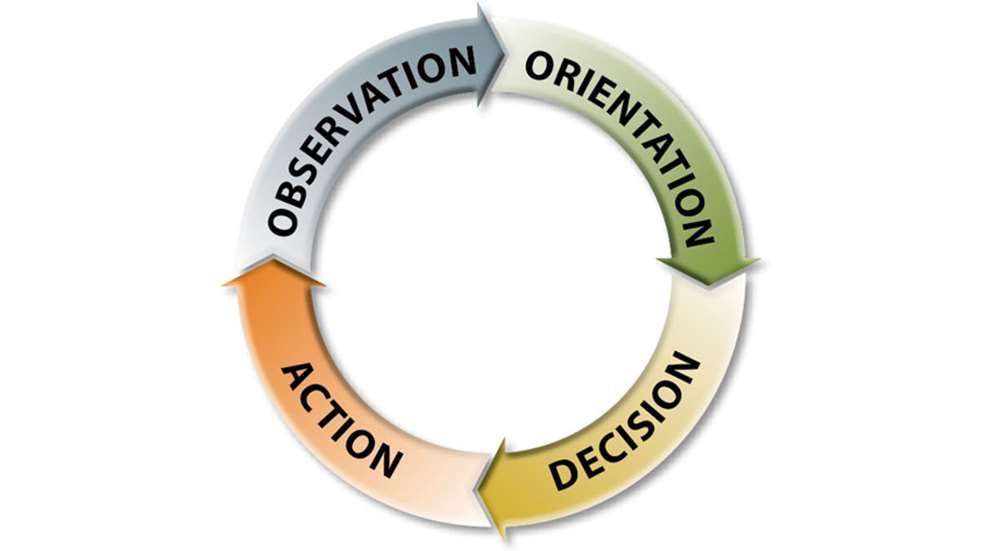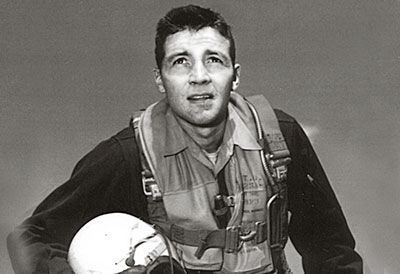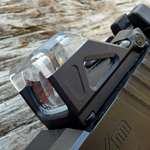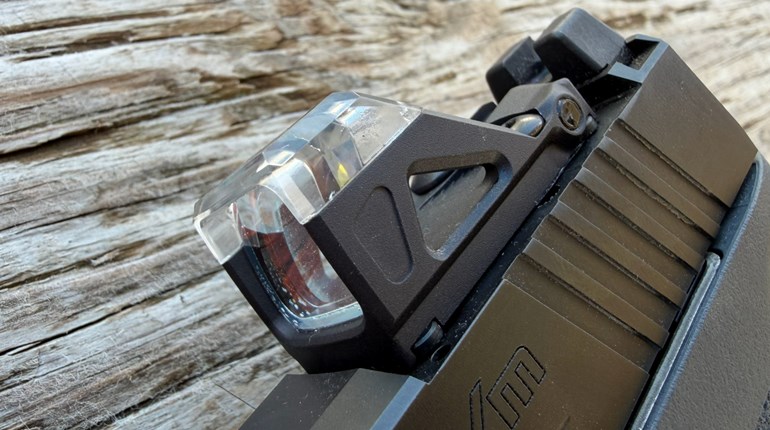
We are constantly interacting with our environment, whether consciously or not. The OODA Loop explains that process and is a vital tool for self-defense.

Col. Boyd served in the US Army Air Corps from 1945 to 1947, and subsequently served as an officer in the U.S. Air Force from July 1945 to August 1975. He was known as “40-second Boyd” for his ability to best any opponent in aerial combat in 40 seconds. When asked about the secrets to his success in aerial combat, Col. Boyd responded with his hypothesis that all professionals “undergo a continuous cycle of interaction with their environment.” This “cycle of interaction,” or the OODA Loop, was subsequently adopted by the military, law enforcement, intelligence and professional-protection communities, where it is still taught at training academies to this day.
The OODA Loop is comprised of four phases in the continuous cycle of interaction with our environment: Observe, Orient, Decide and Act. When you walk into a movie theater, you observe how crowded it is, where the screen, the stairs and the chairs are, etc. You orient to your physical position and determine how far you are from the objects you just observed. The next step in the cycle is to decide which chair you will sit in and then lastly, act on that decision.
Knowingly or unknowingly, we use the OODA Loop for everything from running a business to crossing an intersection. In fact there is no action that we take in our daily activities that is not part of the OODA Loop. The same holds true for how bad guys operate, and knowing this gives you an advantage in solving a tactical problem.
Threat Progression
A threat can start out being only potential—it has the capacity to develop into an undesired event in the future. The progression from potential threat to an active threat is best illustrated by the classic example of a schoolyard bully.
In any schoolyard, there exists a probability that there may be a bully present. If this is true, then we have accurately described a potential threat. Although a potential threat, the capable bully, standing in a schoolyard without motivation or opportunity, poses no actual threat.
The same bully, standing in a schoolyard running his OODA Loop, observes his immediate environment and thinks to himself, “Easy pickings here.” He then orients to his environment thinking to himself, “Hey, I’m the biggest, baddest kid in this schoolyard and I know I can take anybody here.” At this point, he remains only a potential threat. It’s only when he moves to the next step in his OODA Loop that things change.
When the bully arrives at his decision “I’m gonna score extra lunch money,” he crosses that line of demarcation and converts from being a potential threat to an active threat.
Unfortunately, this internal decision-making process is not outwardly observable by anyone other than the bully until he completes his OODA Loop and acts on his decision. The bully, now exhibiting observable attack-related behavior, serves as a confirmation of his status as an active threat.
Motivated by his decision and capable of carrying out his plan, the bully, completing this last step of his OODA Loop, exhibits pre-attack behavior by looking around the schoolyard for suitable prey. He then selects his victim and moves toward him, points his finger at him and, raising his voice, starts shouting, “Hey kid! Yeah you, I’m talking to you!” All of this pre-attack behavior is observable. The last step of his OODA Loop, the physical strike or attack behavior, ends up being a punch in the face for the victim, who is subsequently relieved of his lunch money.
To the untrained eye, the entire incident appeared to be a single snapshot of one kid punching another kid in the face for no reason. But, to the trained observer, it was a clear illustration of the OODA Loop running from beginning to end of the cycle.
How can we use the mechanics of this same cycle to stop a threat? Col. Boyd developed what he called the OODA Loop to describe the repeated cycle of Observation, Orientation, Decision and Action that characterized every encounter—in the air or on the ground, the same principles apply. The key to victory, he theorized, is to get inside your adversary’s loop.

Inside the Loop
A fresh OODA Loop is run at the immediate end of the previous cycle. In practical application of this concept, you are driving along the freeway and observe another vehicle occasionally swerving in and out of its lane. You orient to your distance, speed and position relative to the threat and decide to pass this vehicle. You act on your decision by applying pressure to the gas pedal.
However, just as your acting on your decision and are in the acceleration process, you observe that same driver also accelerates, you orient to the situation in that he’s matching your speed, so you decide to slow down, and act on your decision by relieving pressure on the accelerator allowing him to pass in front of you. You ran two OODA Loops immediately, back to back, with the entire incident taking place in less than 2 seconds.
Reaction time plays a factor in how quickly an OODA Loop is run. Per former FBI agent, firearms instructor and renowned competitive shooter Bill Rogers, the average amount of time it takes for a human being to mentally react to a stimulus, or what he calls “unit of human reaction time,” is approximately .25 seconds. Everyone’s reaction time is different, and the speed at which you run your loop is impacted by this factor. However, just knowing what the OODA Loop is and how it works increases your familiarity with the process, which decreases your response time.
The repeated cycle is a continual stream of running through all four steps of each individual cycle per person. In other words, while you’re running your OODA Loop, the bad guy is running his—the physics of this equation is that only one of you acts while the other reacts to that action.
The Reversal
You arrive at your destination by taxi from the airport and are unloading your bags from the cab when you look up and notice two individuals posted across the street, observing you handling your luggage. When they observe you watching them, they cease their surveillance and walk away. The entire incident took place inside of a second, but from a third-party perspective what really happened was a reversal.
The predators—who you couldn’t initially see because you were in the taxi—were running their OODA Loop. As criminal opportunists, they observed that it was a busy hotel and oriented to the fact that many people leave their bags unattended while their attention is focused elsewhere, then they decided that this would be a great location to position themselves and ply their nefarious craft. In acting out their decision, they set up and started scanning for potential victims.
In rolled your taxi. Your adversaries immediately started their next loop and observed you getting out of your taxi. They then oriented to the scenario that you were focused on talking with the driver while placing your luggage on the ground next to you. They decided you were a valid target and acted on that decision by monitoring your actions while moving toward you.
At this point they have taken the initiative by making the first move. They have taken control of the action-reaction power curve and are currently in control of this incident.
Stepping out of the taxi cab, you, observing that you were in a not-so-nice neighborhood, oriented to the fact that you may be a potential target, so you decided to practice good situational awareness and acted on that decision by looking up, only to see them looking directly at you. Catching them in the act by running your OODA Loop, you cut inside their loop, taking control of the incident by effectively reversing the action-reaction power curve. Now, you put yourself in control of the situation as they scurried off to look for softer targets.
When you got inside their loop, you forced them to run a fresh loop, and in doing so they must re-observe, re-orient, re-decide and (my favorite) re-act to the actions of your current loop. By forcing your adversary into a reversal, you gave them no other choice but to react to your actions, giving you full control of the action-reaction power curve.
The terrorist, predator or opportunist carrying out any planned attack such as a home invasion, mugging, kidnapping, active shooting, etc., has no other option but to follow the preordained cycles of the OODA Loop to ensure their success. Your knowledge of the OODA Loop, how it works and how you can use it to get inside their loop forcing a reversal, is what enables you to control the threat as opposed to the threat controlling you.





































